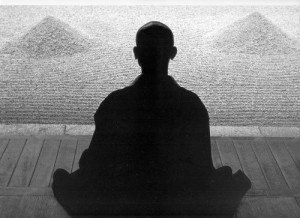The power of meditation is incredible. Just meditating for a mere ten minutes can significantly reduce your stress and boost your mood. However, the biggest reason I do it is to become content with myself. With all the bullshit that surrounds me every day from all aspects of life, it is key to set time aside just for me.
Once you can focus on the current moment everything becomes clearer. Social interactions, working out, your vision, and your family all become more lucid after meditating. It also helps you not worry about things as much.
As humans we are programmed from our ancestors to worry, because that’s what kept us alive as species for so long. Thousands of years ago we had to worry about all sorts of things: predators, foreign armies, and even your own tribe killing you. In our current day in age, it can actually hurt us more than it helps us.
Today humans don’t have much to worry about, so we make up things to worry about. We worry about irrelevant things like what others think about us, what our boss thinks about us, and what is completely out of our control. All this worrying can put a drain on your mind and prohibit you from growing yourself. With the power of meditation you can block out these negative worrying thoughts and begin to focus on what really matters.
As for meditation its self-there are many different forms and names, but for the beginner I have three keys to have a successful session.
1. Have The Right Setting

A big part of meditation is the ability to connect with yourself and only yourself. This is hard to do when you have outside distractions hindering you. That’s why I suggest you meditate in a quiet place that you know you won’t be bothered. It doesn’t have to be absolute silence, but it should be a place where you find peace in.
Also it should be a place that has somewhat dim light. You want your mind to be at peace, and that is hard to do when you have a bright light shining right at you. Some people like to meditate in absolute darkness; while this is better than a bright light, it is not ideal. A lot of the time having no light whatsoever can put a sense of fear in our subconscious, and can hurt your chances of having a good meditation session.
When you’re in your ideal room it is crucial to find a spot that is comfortable to sit for an extended period of time. A floor with carpet is great because it provides stability for your back, but at the same time does not put too much discomfort on the bones in your butt. Another option you might have is a bed. While this does cushion your butt, it can put unnecessary strain on your back, so I do not advise this spot.
2. Set A Time And A Timer

One of the things a beginner to meditation struggles with is the ability to stay focused for an extended period of time. The beginner’s mind wanders easily because it has not yet been trained through meditation. That’s why I suggest beginners start with short sessions and build their way up. A good baseline for the first few sessions is five minutes. While this might not seem that long, it is actually very hard to stay focused on your mantra for this amount of time if you’re a beginner. Once you become more experienced you can go for more time, but at first you must start small so you can train your brain to stay focused.
In order to know when you’ve completed your time you’re going to need to set a timer. Many people advice against this because they say it distracts you from the meditation and more on the timer and when it goes off it abruptly ends your session. While this may be true, if you leave it up to the beginner to time it by himself the sessions will be shorter than intended. A session that he thought felt like was five minutes might have been closer to three or four. There is no cheating with timers.
Once the timer goes off it is important not to suddenly stop meditating. If you just suddenly stop, your results from that session will suffer. Instead when that timer goes off you should continue meditating until you feel content with it. It might be just one more minute of meditating or five more, but the point is that you should go until YOU feel satisfied with the session.
3. Have Something To Focus On

This is probably the most important part of meditating. This could be a mantra or it could just be your breathing, but you have to always return to that to stay on track. A mantra is a word or sound repeated to aid concentration such as “hummm,” but it can also be an word that calms you. In my experience I have always found it best to focus on my breathing, but it is different for everyone. You just have to experiment with all of them to find out which one is best for you.
Once you have that mantra or your breathing to focus on, you’re going to have hold on to that focus through the entire session. This may be really hard for a beginner, and you will find that your mind will wander onto other things about your daily life, but recognize those thoughts and shut them down and return to your focus.
In those first couple sessions these thoughts are going to pop into your head all the time, but don’t let that discourage you. The key for the first few sessions is having the ability to recognize these outside thoughts.
Switching up your focus throughout sessions can also be beneficial. Try switching up a focus to every other session to experiment with what fits best.
Conclusion
All of these things above are great pointers, but the best learning material is experience. Through experience you will find what fits best for you and what your goals are with meditating. Use this article for help, but don’t rely on it and also don’t get discouraged if you don’t find success in your first few sessions. It will come to you it’s a matter of time and persistence.
Read More: The Top 5 Benefits Of Meditation For Men
This is an excellent article on spirituality and personal development.
My personal routine is waking up at 4am (first started at 6am, then 5am, and now 4am) and immediately drinking a full glass of water, then brushing teeth and taking a cold shower (15 minutes, and then waking up my wife), reading my religious hymns (20 minutes), physical workout routine (variety of bench press, pull-ups, push-ups, jump-squats, etc.) (30 minutes), breakfast of milk+cereal and mixture of nuts and a banana (15 minutes), then catching up with news around the world and reading more (religion, philosophy, politics, history, etc.) for about an hour or so.
From my personal experience, the morning before sunrise is the best time to get all this done as later in the evening, there will always be interruptions and distractions that will pop-up and will hinder you from your personal development and spiritual progression.
For those who’ve never tried meditating, I’d highly recommend you try it out for at least a week. After some experimentation, you’ll find out what time works best for you.
By the time I’m done, it’s about 6:30am. I call this “bootstrapping” (like a computer) and after this, I’m ready for the rest of my day. It is vital to make sure you take care of your mind and your body and that both are in most optimal condition. My wife and I go to sleep together at 9pm, 9:30pm at the latest.
You will definitely feel much more relaxed and you’ll slowly start picking up other good habits along the way as well.
Wake me up at 4:15am., unless the bed is on fire, and you will be meditating from the ER.
Consider the spiritual exercises of St. Ignatius Loyola for Christian meditation.
Added to my reading list.
So are we talking eyes open or shut? And what about lying down vs sitting up?
I find that it works for different people in different ways. I usually lie down, and enter meditation with a self-hypnotic progression (progressive relaxation, starting with eyes open and ending with eyes closed, etc.), but I can’t say this has worked for anyone else.
These tips are great for everyone, because they eliminate common distractions (discomfort, time-based concerns, and lack of direction).
OK thanks, so would it make sense to meditate in bed after you wake up but before you get out of bed?
Sure, why not? Make it a goal to find the optimal time and place for your meditation.
My morning routines have fallen off (shame on me), but I used to have a speedy regimen of workout, shower, hygiene, breakfast, followed by a half-hour to meditate. That worked out pretty well when I was doing it.
Meditation is a funny thing. I started off 15 years ago. Kind of with the sensitivities of a left wing new ager. But I think it was meditation that ultimately drove me away from the secularist left. And led me to value spiritual tradition.
Makes sense. Once you get to reconnect with those masculine energies and actually let yourself feel all the pain in your life, you suddenly realize the real culprits.
Left wing new age spiritualists are addicted to the feeling of moving energy. They use the feeling of movement as a crutch to avoid feeling themselves directly. However, their starting point for meditation and energy work is good enough for anyone to use as a starting point. And they don’t know they’re addicted to moving energy; which usually means that what they tell people to do is close enough to correct, even though they don’t do it themselves, and can’t help people achieve it beyond a certain point (and at an even farther point, they’ll tell people who are doing it right that they’re doing it wrong, and actively try to stop them).
Anyway. Point is: awesome. Good on you.
Ya even though it’s boring if you don’t know your own mind you miss so much of the bigger picture.
Actually, my meditations are quite the opposite of focusing on something. I think it would quite hamper my efforts. I basically just use instructions from my mentor to activate some chakras and then I simply observe whatever happens and thus I kinda sweep through everything that is in my mind. A bit like cleaning up a messy room.
“focus” is a word which to some people means the same thing as awareness, and to others contradicts awareness. Awareness is the “correct” word.
There are people who can’t be aware, but can focus. They have to start somewhere. If they start by controlling their focus, they’ll end up bringing their awareness to their ability to focus. At some point, someone has to tell them that focus isn’t the same thing as awareness, but that’ll be a couple years down the road.
That is interesting. So I guess this stuff is indeed different for everybody.
There is no reason to practice meditation unless you are dating a woman who can put her ankles behind her head.
The ‘feet behind the ears’ is a standard yoga move. I don’t know the specific name for it, but once a person can achieve the position, with regular practice, perhaps three times daily, a person should be able to maintain the agility to assume the position for years to come. This lady demonstrates the position well. This is a CLEAN video so kids gather round. I never had interest in the alien sounding twangy Tibetan music before, but I kind of like the music now:
https://youtu.be/c3mFcbmDKCE
Good article and meditation is actually something I’ve wanted to look into more.
I meditate on the toilet.
Don’t agree with tip 3. Have something to focus on , just what the mind needs less of, things , thoughts , focus . Just be , no focus no mantra , just be! no systems . You can’t get to that which is sacred using mind , by not using mind sacred comes to you ! Attention and awareness will be more beneficial to you than focus . Oh and ear plugs can sometimes help .
Here is a simple no-nonsense meditation technique I use that I think ROK readers would appreciate. Works wonders for me. You can do this with your eyes open, so feel free to try these steps as you read them:
1. Sit upright and erect without resting on the back of your chair.
2. Take your index finger and middle finger of your left hand and place them on your “third eye” (the spot between your eyebrows).
3. Take a deep breath and hold it.
4. Now repeat this mantra out loud: “kraaaatooooommmmmm.”
I looked like fool laughing out loud at work because of this post. Thanks
underrated post right here.
Be careful. There are many ways to “shut down your thoughts”. Some of them are bad, while others good, and progression is possible. The end goal for this beginner level should be to be able to return to your focus without having to shut down your thoughts.
Step 2 for beginners should be: play with the shape and location of the focus until you can control it while in a meditative state. Expand and contract it, and move it around. Inside and outside of your body.
Step 3 should be: Pass the focus through your body from top to bottom, slowly, allowing all thoughts and feelings that come up to be and do their thing. Be aware of their existence, but don’t focus on them, and don’t interfere with them.
Once someone can do that repeatedly, that’s when they can start doing the interesting things with meditation.
For anyone interested, the “interesting things” that can be done with meditation start with: Set your focus as a feeling or thought which you had or have (or a specific “troublesome” location in your body), and follow it as it unravels, revealing more and deeper thoughts and feelings hidden inside. That’s a basic skill of meditation which is used even through master level meditation.
Meditation practically saved my life. Quit smoking, returned to semi-professional tennis form, refocused my energy on a specific target or outcome, lowered my stress and anger without making me soft – and helped in long negotiations by giving me patience. Yoga is worthless for me, so to each his own. (That’s what the gym is for).
Some believe in not focusing on anything, just “being.” But in y experience, reaching a trance through intense focus is what worked. See “Conquest of Mind” by Eknath Easwaran for an exposition of that argument.
Guided meditations help immensely.Without those I wouldn’t meditate at all because each time I tried to focus in silence I would just get angry at myself for getting distracted easily.There is a YT channel “The honest guys” with awesome guided meditations that last anywhere from 5 minutes up to an hour.Highly recommended.